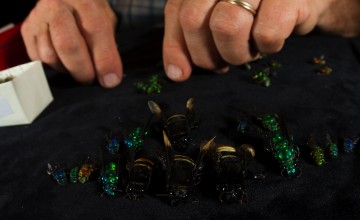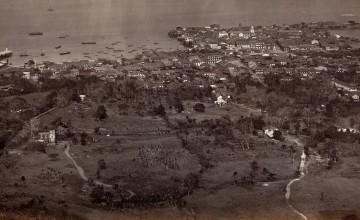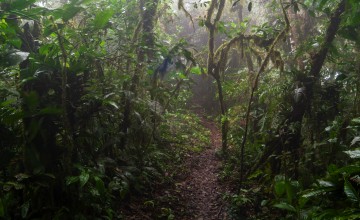
David W.
Roubik
Each natural community, or assemblage of organisms, has its own analog to an immune system. When humans take charge, they’d better either let nature have its way, or go in with a plan to use the right organisms, in the right way, and at the right time, before the resident community, and all its associated physical entities, terminate it. We, as scientists, are now in the spotlight to show what is ‘right’.
Projects and Stories
Recent Publications
Research Focus
I’ve gotten used to performing long-term studies, and shorter-term field experiments, but most of all try to mix and match what is both interesting and useful. Many studies have come to fruition, and those I continue to expand consider 1) ecology and taxonomy of stingless bees and orchid bees, 2) island biogeography of bees, and 3) reproduction by dioecious tree species. I joined the Smithsonian in Panama to address an urgent need to predict the impact of Africanized honeybees as they spread north from Brazil. I came from an ecology and taxonomy background. My collaborators and I currently explore how the natural role of bees as pollinators, or as producers of human food and benefits, function and are maintained, even as agro-ecosystems push them around. I edit, write and review many publications, because we are advancing rapidly. There are bright spots — because novel communities are often sustainable — at least from a scientific perspective. I see competition among pollinators as a different kind of paradigm in ecology, because losers win and winners may lose. That is because they are within networks and actually feed one another, and change over time. I try to balance my research with field biology, academic depth, museum research, and applied goals, and have a splendid base for that at STRI.
Contact
Research Overview
How are tropical bees agents of connectivity?
Bees, like microbes, live everywhere and interact as parasites, commensals and mutualists. They are not boxes of insects — they are 30,000 species living primarily in the temperate zone, without honey, queen, or castes, solitarily, and do amazing things, including making possible the reproduction of roughly half of all plants. Bees have deep relations with bacteria, fungi and archaea. They are much more likely to be social or make honey, or be present at flowers, in the tropics, where their total species richness is nonetheless much lower than in many warm temperate areas.
How is it that at the peak of social evolution in insects, there are honey and social bee colonies, with a queen, workers and drones, and why is this fact such an important feature among tropical, human societies?
Insect colonies — big ones — need to store fuel, materials, and protein to continue. Their dispersion matters. Their defenses from enemies must be well coordinated. Their need for making the most of stored protein, carbohydrates, etc. involves managing their microbial communities and propagating them through generations. People believe that bee food, including larvae, honey and pollen or ‘bee bread’ and propolis (a resinous mixture of building material) have medicinal value. The chemical, microbiological and botanical components are ripe for further investigation, especially in the tropics. Honey from native vegetation is usually from about 50 plant species, making honey the most biodiverse natural product.
How can we adequately measure the abundance of natural pollinators and decide what to do to better conserve them?
Animal populations never are stable. Surveys of living organisms, like bees or other pollinators, are few and far between, and often do not consider biologically important ‘recent’ events — e.g. periodic El Niño-Southern Oscillation droughts which are highly positively correlated with flowering peaks and bee populations, or heavy rainfall, or human impact. Bee nests are in the soil, in dead branches, in living trees, in tilled land, in urban areas, or in forest. Not all bees are the same, their parasite and predator pressures differ, their reproductive seasons are diverse, in the case of bee colonies, whole-colony reproduction does not occur with a high predictably. We need to make more efforts to fill our knowledge gaps, by making comparative studies.
How can we predict or understand the competition in complex networks like those involving pollinators and plants — which I have termed “silent competition” where there are no clear winners or losers — at least in the short term?
Competition theory never explained much about pollinators. Their interactions are properly defined in networks, in which they are facilitators, competitors or flat-out mutualists, simultaneously. It is a question for integral calculus, not short- or medium-term field experiments (which is the best that I or others can do, for a number of reasons), or based on a simple matrix or network. The Africanized honeybee studied for 17 years pre- and post-invasion in Yucatán gave us a reference point. They caused resource partitioning, and then evidently an expanded resource base, which their competitors benefit from. This is not Lotka-Volterra anymore.
Education
University High School, Minneapolis, Minnesota 1965-69
University of Minnesota, Minneapolis; advanced Spanish 1968-69
Macalester College, Saint Paul, Minnesota; Humanities 1969-71
University of Washington, Seattle; Liberal Arts 1972
BS (entomology) Oregon State University 1975
Ph.D. (entomology) University of Kansas 1979. "Competition Studies of Colonizing Africanized Honey Bees and Native Bees in South America"
Selected Publications
Pot-Pollen: Stingless bees in Melittology. (2017). (Editor, with P. Vit and S. R. M. Pedro). Springer, New York.
The Pollination of Cultivated Plants. A Compendium for Practitioners (2017). Editor. FAO, Rome.
Orchid Bees of Tropical America: Biology and Field Guide (with Paul Hanson, 2004). InBio Press, Costa Rica.
Pollen and Spores of Barro Colorado Island. (with Enrique Moreno, 1991). Missouri Botanical Garden, St. Louis.
Ecology and Natural History of Tropical Bees. (1989). Cambridge University Press, New York.


